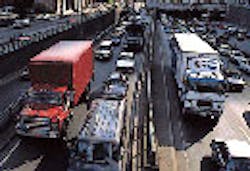What is the event or reason that makes truck-car collisions unavoidable? This question was discussed thoroughly by Ralph Craft, senior transportation specialist for the Federal Motor Carrier Safety Administration’s (FMCSA) Office of Analysis during a teleconference yesterday.
FMCSA was mandated by Congress to do a study of 1000 large truck crashes, preparing a report originally released in May of 2006. Craft expanded on the report’s findings and spoke on what FMCSA hopes to do to reduce serious crashes between trucks and cars. Further analysis of causes may help reduce the 50,000 accidents each year between cars and trucks that result in about 3,000 fatalities.
According to Craft, there are three variables that explain a crash between a truck and a passenger car. The first is the critical event—the reason a crash was unavoidable. Secondly, there is the critical reason—the immediate reason the critical event took place. Lastly, there are associated factors—factors that were present at the time of the crash that don’t always cause crashes, but increase the risk that one may occur.
The most common critical events that cause crashes are running out of the travel lane, crossing through intersections or hitting a vehicle stopped in the lane, the study said. Craft said that the four most common critical reasons for these events—non-performance due to factors such as sickness or sleepiness; inattention or recognition; poor decision-making and overcompensation—all relate to the driver and not the vehicle.
“Sixteen of the twenty-four [most common crash] factors relate to the drivers and not the vehicle,” Craft said. “There’s plenty of blame for large trucks, buses and passenger vehicles in crashes, but the ‘causative’ factors lie mainly with drivers…the vehicle issues are secondary.”
It’s hard to do much about some of these causes. “It’s very difficult to legislate many of these factors,” Craft said. “Can we make it a crime to be distracted? We need to do more research in human behavior and do things above and beyond what we can legislate…we want to find the factors that FMCSA can do something about, through research and education.”
Vehicle problems that are a major factor in accidents occur far more often in trucks involved in crashes than they do with cars. According to the study, 27% of the trucks in accidents had brake problems, compared to only 2% of cars. And a vehicle being overweight was the number one causative factor for a truck crash.
“Trucks are coded with vehicle problems twice as often as passenger cars—they have more parts, more lights, more wheels, etc.,” Craft added. “Also, when trucks are overweight, it makes them more unstable and more likely to roll over.”
